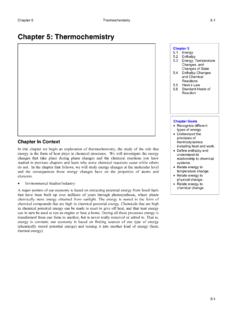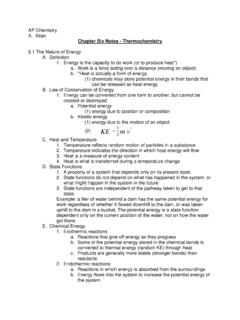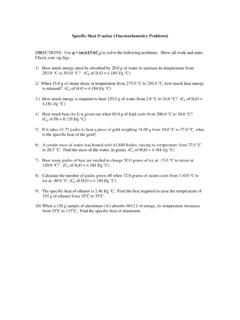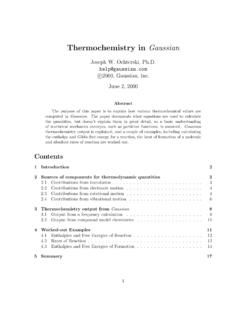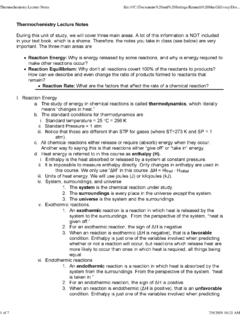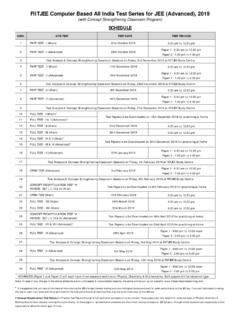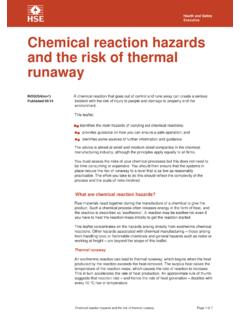Transcription of 11 Thermodynamics and Thermochemistry - Premed411.com
1 Copyright 1996 Richard Hochstim. All rights reserved. Terms of use. 37. 11 thermodynamics and thermochemistry Thermodynamics is the study of heat, and how heat can be interconverted into other energy forms. In Thermodynamics the system is a specific part of the universe that is being studied, often the system is a chemical reaction. The surroundings are all parts of the universe that are not the system, typically everything outside the test tube. An open system can exchange both energy and matter with its surroundings. An active volcano is an example of an open system. A closed system can exchange energy but not matter. A sealed greenhouse is a closed system. An isolated system can exchange neither energy nor matter. A sealed thermos bottle is a isolated system. Properties of a system which depend only on the final and initial conditions of that system are called state functions. State functions are independent of the path which is taken to go from an initial state to the final state.
2 The state functions we will be working with this chapter are listed below: P, pressure; V, volume; T, temperature; E, internal energy;. H, enthalpy; S, entropy; G, free energy. The First Law of Thermodynamics The first law states that energy can't be created or destroyed. In other words, when a system gains or losses energy from the surroundings, the total energy ( , the energy of the universe) will be constant. This is concept is expressed mathematically as: E = q + w . The E ( U) represents the internal energy, this includes, but is not limited to, all kinetic and potential energy possessed by all components of a system. E is the change in the internal energy of a system as the result of heat flow and work. Heat flow is indicated by q, and work done by the system is w. The conventions that apply to the above equation are: q is a positive value if heat is absorbed by the system, q is a negative value if heat is lost by the system, w is a positive value if work is done on the system, w is a negative value if work is done by the system.
3 Question . A system gains 100 calories of heat and does 75 calories of work, what is the change in the internal energy of the system? 38 MCAT EXCELERATOR. solution: Since heat is absorbed by the system the value for q is +100 cal. The value for w is -75 cal because the work is done by the system. Substituting into the equation gives, E = +100 + (-75). E = +25 cal.. Work We previously defined work, w, as force times displacement. Now we will look at an alternative definition. The work done by a system is equal to the negative value of the external pressure multiplied by the change in volume of the system. Work = -P V. Equation Based on Equation # we see that when a system's volume increases, it is (by definition) proforming negative work. ( Remember by definition means there's no reason why it couldn't have been positive in fact a few years ago it was!). question . A system expands from an initial volume of m to m against a pressure of 10 fi Pa. What is the work done by the system?
4 Solution: W = -P V, W = -(10 fi Pa)( m - m ), W = fi J.. If you check out an older text you might discover that the first law used to be defined as E =. q - w and work as +P V. Don't Panic! The MCAT-People will use the newer definition and will not ask any questions which could be misinterperited because of this change I hope! Constant Conditions Here's a list of how the first law behaves when various conditions are held constant. Under conditions of constant volume V = 0. Since W = P V, W = 0 and E = q. When there is no heat flow heat flow, q = 0, and E = -w. When the temperature of a gaseous system is constant, E = 0 and q = w. Recall that the internal energy is directly proportional to its temperature. When the external pressure remains unchanged, q is referred to as the the change in enthalpy, H. Under these conditions the first law may be rewritten as E = H - P V. In a chemical reaction in which the number of moles of gas is constant, V = 0, and E = H.
5 Question . In which of the following reactions will the value for E be greater than that of H? A. CaCN (s) + 3 H O (l) CaCO (s) + 2 NH (g). B. 3 H (g) + N (g) 2 NH (g). C. UO (s) + 4 HF (l) UF (s) + 2 H O (l). D. H (g) + I (g) 2 HI (g). Copyright 1996 Richard Hochstim. All rights reserved. Terms of use. 39. solution: From E = H - P V it is clear that if the value for work, P V, is negative, E will be greater than H. For any reaction that consumes more moles of gas than it produces the value for Vwill be negative. Answer choice B produces 2 moles of gas while consuming four moles of gas. Its final volume is less than its initial volume. This results in a negative value for work and a value for E > H. So answer B is correct. Answer A results in positive work, so E < H. Since there are no gases in answer C, w = 0 and E = H. Since there is no change in the number of moles of gas in answer D no work is done and E = H.. Enthalpy Enthalpy, H, is a state function used to describe the heat changes that occur in a reaction under constant pressure.
6 When a reaction is allowed to take place in an open container a quantity of heat proportional to the quantity of matter present, will be released or absorbed. This flow of heat is the enthalpy change, H. The units for H are kJ (or kJ/mol). Reactions that release heat are termed exothermic, they have negative values of H. Reactions that absorb heat are termed endohermic, they have positive values of H. The endothermic reaction shown below indicates that kJ are absorbed when 2 moles of NH . decompose to form 1 mole of N and 3 moles of H . 2 NH (g) N (g) + 3 H (g) H = + kJ. question . In the reaction above 100 g of NH are allowed to react to produce N and H , how many kJ of heat will be absorbed? solution: The reaction indicates that for every 2 moles of NH consumed, kJ. will be absorbed. This information will be used in the calculation below to convert from moles of NH to kJ. mol NH kJ. 100 g NH x x = 271 kJ . 17 g NH 2 mol NH . When a reaction is reversed, the sign of H is changed: N (g) + 3H (g) 2 NH (g) H = kJ.
7 When a reaction is multiplied through by a number, H is multiplied by that same number: [N (g) + 3H (g) 2 NH (g) H = kJ] =. 1/2 N (g) + 3/2 H (g) NH (g) H = kJ. Good news, the above two rules work in exactly the same manner when S and G are involved. 40 MCAT EXCELERATOR. Hess's Law Hess's law states that the enthalpies of reactions may be added when these reactions are added. Substances appearing on the same side are added, while those on opposite sides are subtracted. Typically, some reactions will need to be reverse and multiplied through by a number, so that when they are combined the desired equation will result. question . Find the enthalpy of the equation: C H (g) + 5/2 O (g) 2 CO (g) + H O (l), given the following information: (1) 2 C (graphite) + H (g) C H (g) H = + kJ. (2) C (graphite) + O (g) CO (g) H = kJ. (3) H (g) + O (g) H O (l) H = kJ. solution: Since C H (g) appears only in equation (1) it is necessary to reverse equation (1) so that the C H appears on the left hand side to correspond to the desired equation.
8 Since CO (g) appears only in equation (2), it is necessary to multiply equation (2) by two, so that two CO 's will appear on the right hand side. Since H O (l) appears only in equation (3), there is no need to alter this equation since one H O appears on the right hand side of equation (3) and this is exactly what is required in the desired equation. C H (g) 2 C (graphite) + H (g) H = kJ. 2 C (graphite) + 2 O (g) 2 CO (g) H = kJ. H (g) + O (g) H O (l) H = kJ. _____. C H (g) + 5/2 O (g) 2 CO (g) + H O (l) H = kJ.. Standard Heat of Formation A substance in its most stable form at one atmosphere is said to be in its standard state (the temperature need not be 25 C, but this temperature is most commonly used to tabulate data). The enthalpy change which occurs when one mole of a compound is produced from its elements in their standard states is called the standard heat of formation, H . The equation for the standard heat of formation for ammonia, NH , is given below: 1/2 N (g) + 3/2 H (g) 1 NH (g) H = kJ.
9 By definition all elements in their standard states have a H equal to zero. Standard Heat of Reaction When all substances in a chemical reaction are in their standard states, the enthalpy change is called the standard heat of reaction, H standard heat of reaction may be found by taking Copyright 1996 Richard Hochstim. All rights reserved. Terms of use. 41. the sum, , of the standard heats of formation of the products, and subtract them from the sum of the H 's of the reactants. The coefficients in front of each substance must be multiplied by their respective H 's. H rxn = [ H (products) ] - [ H (reactants) ] question . Using the above formula, find the enthalpy of the equation: C H (g) + 5/2 O (g) 2 CO (g) + H O (l), given the following information: (1) 2 C (graphite) + H (g) C H (g) H = + kJ. (2) C (graphite) + O (g) CO (g) H = kJ. (3) H (g) + O (g) H O (l) H = kJ. solution: Let we let (CO ), (H O), (C H ), and (O ) represent the H of CO , H O, C H , and O , respectively, we get: H rxn = [2(CO ) + 1(H O)] - [1(C H ) + 5/2(O )].
10 H rxn = [2( ) + 1( )] - [1(+ ) + 5/2(zero)] = Bond Dissociation Energy The change in enthalpy required to break a bond is call the bond dissociation energy (or bond energy). When bonds are broken energy is absorbed. When bonds are formed energy is released. Here's the equation for the bond dissociation of hydrogen: H (g) 2 H (g) H = +435 kJ. The larger the bond energy, the greater the bond's strength and the shorter the bond's length. The enthalpy of a reaction may be determined by subtracting all the bond energies associated with products form those associated with the reactants: H rxn = [ Bond E. (reactants) ] - [ Bond E. (products) ] . Equation Note that in this equation it is the bond energies of the products which are being subtracted. for the reactants. question . Using the above formula, estimate the enthalpy of the equation: C H (g) + 5/2 O (g) 2 CO (g) + H O (l), bond energies are given below in kJ/mol. C C H C H O C O C C C C O O. 347 414 464 803 611 837 498.
